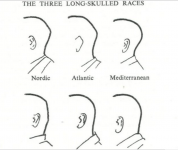Moesan, I'm not sure what you're talking about. A tendency towards a higher relative vault and increasing breadth of the neurocranium are distinctly human adaptions - these are not 'archaic' features as you call them. A simple look at Erectus and Neanderthal skulls would have disabused you of that notion. The bony protuberance at the back of the skull is found in most long, low-vaulted neurocrania. This cannot be a feature of 'race'.
Your remark evocates me the dogmatic anthropology/biology lessons learned and regurgited by good pupils (LOL) - maybe I misunderstand your answer - it's very good to observe with his own eyes, at big scale, and not only read what say others - but my own words were confusing in some way; when I speak of archaïsm I speak of old forms of our 'europoid' phylum not of the entire 'homo' chain, and withtout any value judgement concerning intelligence - but in my posts, I show ancient forms spite showing traits which are "archaïc" for our phylum,
are not so uniform; I am not hidding myself behind this term - and do'nt forget: the more dolichocephalic 'brûnn' types had higher skulls (above ear hole) than the 'croma' !!!
and please don't play with the "race" concept - "race" (rather type here) is a consequence of a sum of diverse adaptations BUT NOT ONLY, some mutations can be without too much effect on life, so I would rather say the sum of diverse not evenly shared all of them in all the human groups, and when a new type of genes incorporate a genom, the result is not the same according to the previous combinaison of genes, what I call "background", in fact genome - you say adaptation: maybe, but not only (all is not selection, hazard exists too) - and to back my affirmation, you can see the recent evolution of modern men: are they all of the same shape, even when living and mating since generations in the same climate and culture in the same time?
protuding occiput with dolichocephaly?:yes, more flattened occipital part with brachycephaly?: yes: 'mechanical' effect - but it's not all the story - 'mechanical' processes linking some features exist but they don't explain differences of shapes (numerous) -
do read my posts: you see different shapes (observed by others than me) of occipitals within dolicho's AND within brachy's in the europoid group; why? History of hazard and selection(s), sure, but it can help to distinguish between different stories of human subgroups, what doesn't the only ad global useless concept of adaptation which says everything and nothing, spite it's undiscutable -
to come back to the word 'archaïc', it's a good word to oppose in a relatively close genetic group, the pre-adaptation and the post-adaptation forms -
I know some "scientific" postulats which turned false: the human beings will grow higher, and their skull will grow higehr and larger on every dimension, maybe more rounded, and the foreheads will become steeper: we are far from this, and if skulls don't become smaller, in proportion of body, they are rather modest; the foreheads are not stepper, maybe the contrary (perhaps a slight more protuberance of browridge due to stature increase? - and the sksulls grow rather more dolichocephalic, whatever the study young people do -
I have no explanation - perhaps at some time of humanity evolution, the lack of physical fitness of Humans in the nature urged the selection of capacities of intragroup solidarity and intelligence in absence of force? Perhaps the today domination of Mankind upon the fauna makes this first adaptations less useful? But to go farther, when you look at scholars skulls, you can see everykind of skull profiles what can interrogate the concept of skulls shapes tied to adaptation; so many factors are in play, it's true (today, principally the (bad)food and the lack of physical activity (except the fingers!) -



